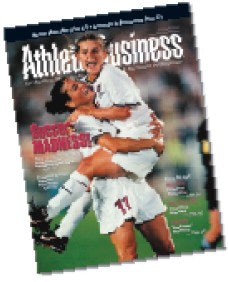The failure of the Women's United Soccer Association

The failure of the Women's United Soccer Association - announced, with spectacularly bad timing, during the week leading up to the Women's World Cup - has given plenty of professional ruminators the opportunity to hold forth on Americans' collective failure. Isn't it a shame - a crime! - that corporate America refuses to back women's sports? That we, the fans, refuse to watch soccer - and worse, that we refuse to support women's sports. How can we look at ourselves in our collective mirror?
Let's leave aside for a moment the salient fact that these selfsame professional ruminators gave the WUSA 10 times the ink in death that they gave the league throughout its three-year history. Or, better yet, let's not. Shouldn't the consumer media share some of the blame here?
Not really. Clearly, the WUSA's failure was a result of market forces on the one hand, and the WUSA's own fundamentally flawed business plan on the other.
The American market is, first of all, soccer-unfriendly. The old joke - Why do so many people play soccer? So they won't have to watch it - is valid today even though interest in playing soccer is higher than ever before. The market, also, is oversaturated - with a few exceptions (February comes to mind), the sports calendar is full to overflowing, and operators of startup leagues face numerous challenges in being heard.
As Athletic Business reported in November 2000, one of the things the WUSA had going for it was a group of investors with ties to cable television. But a reality of programming is that you can't force people to watch - and people didn't. The WUSA scored a 0.1 percent rating on cable station PAX and 0.2 percent on ESPN2.
And what about the league's business model? On one subject, attendance, they were remarkably prescient. WUSA Commissioner and former Team USA Coach Tony DiCicco said exactly three years ago in these pages, "Our business model is for a 6,500 average. We're hoping to do better than that, but we're trying to be conservative and realistic." Amazingly, the WUSA did almost exactly that: After a one-year spike in interest, WUSA attendance in its third season had settled at a per game average of 6,667 fans.
Right about now you might be asking yourself how the WUSA managed to rack up what league founder John Hendricks estimated to be just short of $90 million in losses in three years. Think about that figure: The league met its attendance goal, forced its players to accept pay cuts on already low salaries, had no money tied up in stadium construction or debt, and lost $90 million. What would the losses have been if even fewer fans had showed up?
Hendricks, the founder of the Discovery Channel, told reporters that lack of corporate support for the league was to blame for its demise. If that's so - if a league owned and operated by corporate America can be said to lack corporate "commitment" - then the underlying problem is not just with the WUSA's business model, but with the model for startup leagues in general.
Bill James, the noted baseball thinker and now Boston Red Sox consultant, has written eloquently on the rise of professional baseball in the 1800s. Back then, players participated, and people showed up to watch, because they loved the game. Eventually, barnstorming teams passed a hat at games to recoup some of their expenses. And sometime after that, after stands began to ring the fields to accommodate burgeoning crowds, marketers (they weren't called that then, but that's what they were) realized they could charge bigger sums because those not willing to pay wouldn't get a seat. The first sports team "owner," in the modern sense of the word, didn't yet exist. Personal seat licenses were still a hundred years away.
The "madness" of the WUSA is the same as that of the XFL. The assumption is that a new league must be "big league" from the start, with fat TV contracts, fatter owners and made-to-order cheering throngs that require club seats and a Jumbotron to be entertained. It must go national from day one - a proposition that leads to astronomical expenses and ignores the fact that traditional sports rivalries were regional, not national.
In short, the WUSA thought too big. What it needed was a 19th-century kind of plan: A dozen teams in close proximity (in the Boston-to-North Carolina corridor, maybe) fighting for glory in the name of their respective small to medium markets. They could use some of the players' Nike sponsorship money to seed the league, work deals with municipal stadiums, post a schedule on the league web site and use every possible medium to get the word out, and pass the hat at games. The players would own the league, since they would be the ones who people paid to see. Eventually, corporate and league interests would dovetail, as many local, regional and even national businesses would want to reach the soccer demographic. Eventually, other markets would put together teams, and the league would expand.
Such a league might toil in relative obscurity for decades, as the National Football League and National Basketball Association did, but it sure as heck wouldn't lose $90 million. And one day, a league built from the ground up by soccer players and their fans, and not by corporations, could even rival other wellestablished sports.
Or does that sound crazy?




































